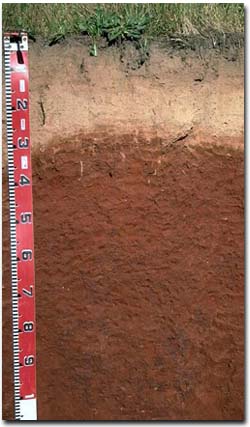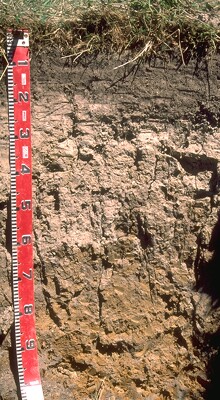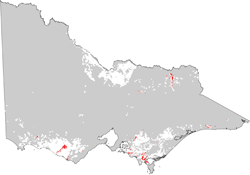Victorian Dairy Soils - Kurosols
Back to: Victorian Dairy Soil
Kurosols (Australian Soil Classification) are soils that have strong texture contrast between the surface (A) horizons and the clay subsoil (B) horizons. The subsoil is strongly acid, i.e. pH is 5.4 or less in water, and non-sodic (at least in the upper horizons).
 Red Kurosol in north-east Victoria |  Brown Kurosol near Fish Creek in southern Gippsland |
Distribution
| Brown and Yellow Kurosols are most prevalent on some of the less steep hills in the Otway Ranges, to the north of Lorne, and on lower slopes and valleys in the deeply dissected terrain in the Heytesbury region. They are most likely to occur in areas with average annual rainfall of over 600 mm. Soil pit site SW31 is an example of a Brown Kurosol soil profile near Gerangamete. In far western south-west Victoria, in the Portland region, Kurosols with sandier surface horizons are common. In Gippsland, Brown Kurosols generally occur in higher rainfall parts of the region and have largely developed on Palaeozoic sediments and some on the Cretaceous and Tertiary sediments. Soil pit site SG11 is an example of a Brown Kurosol near Fish Creek. In north-east Victoria, Red Kurosols are widespread on the lower valley slopes, fans, higher terraces and residual hills in higher rainfall areas. Soil pit site NE26 is an example of a Red Kurosol profile in the Tallangatta Valley. |  |
Management Considerations
Texture contrast soils usually have restricted root and water movement into the clay rich subsoils.
The surface soil is often strongly acid and consequently aluminium and manganese toxicity may occur. Raising the pH level of the surface soil will help reduce that toxicity. A lime test (sampled at the paddock level) may be appropriate to determine how much lime is needed to raise pH levels. Other factors need to be considered, however, before lime is recommended (e.g. species grown, method of application, local trial responses, likely cost-benefit). Molybdenum deficiency may occur in the strongly acid surface soil and manganese toxicity can also occur, especially when waterlogged. Lime application will make molybdenum more available to plants. The upper subsoil in Kurosols is also strongly acid but more difficult to ameliorate with lime.


